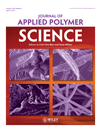Evaluation of the availability of easy cationic dyeable copolyester fibers as electrostatic flocking piles
Abstract
Easy cationic dyeable copolyester (ECDP) fiber produced by the copolymerization of sulfoisophthalate acid groups and poly(ethylene glycol) with poly(ethylene terephthalate) improves the dyeability compared to regular polyester (PET) fiber; this has resulted in a growing increase in its applications. However, there is little research involving their application in electrostatic flocked fabrics. In this study, we investigated the properties of ECDP fiber, and we discuss their availability for use as electrostatic flocking piles and also compare them to PET fiber. The experimental results show that ECDP fiber possessed a lower crystallinity degree and tensile strength, better conductivity and moisture absorption capability, and higher elongation than PET fiber, mainly because of the copolymerization of sulfoisophthalate acid groups and poly(ethylene glycol). The pretreatment and electrical treatment introduced in this study significantly improved the flocking properties of ECDP and PET piles, especially ECDP piles; they achieved a more pronounced improvement because of their better affinity. With regard to the flocked fabrics, the ECDP flocked fabric had a much higher flock density and a lower weight loss in the wear-resistance test than the PET one and nearly the same good wear resistance as the commercially available polyamide one; this indicated that the ECDP fiber examined in this study could be successfully used to produce flocked fabrics. © 2010 Wiley Periodicals, Inc. J Appl Polym Sci, 2011




